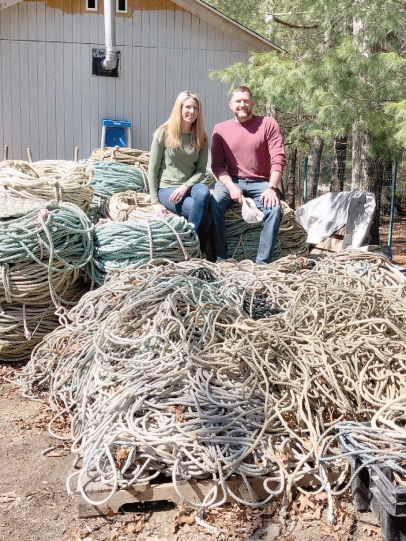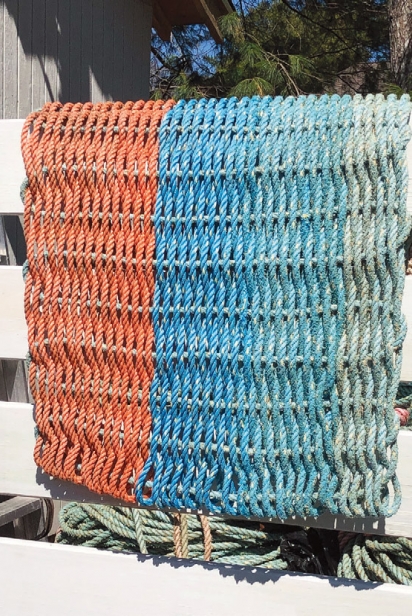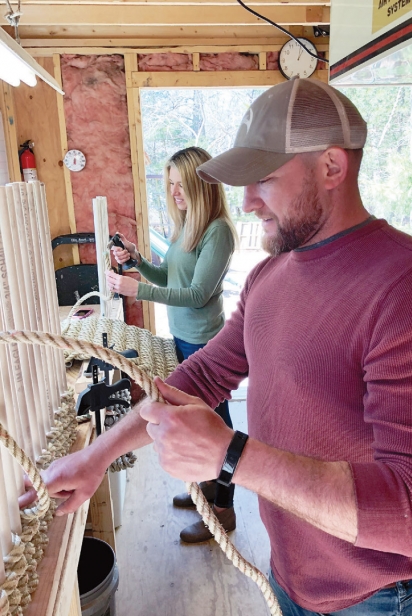Cape Cod Lobster Mats
Three years ago, John and Alicia Morgan were watching an HGTV program about a Maine cabin renovation when John saw a woman with mounds of float rope – lobster trap lines – stored in her yard. She was weaving doormats out of it. He looked at Alicia and said, “We could do that.” And so, they did. Shortly thereafter, they rescued their first batch of used rope from the Sandwich transfer station.
John and Alicia are both Massachusetts natives and, after moving around a bit, settled in Sandwich seven years ago with their son, Jack, now age eight. Brooke, age six, came along a year later. Alicia worked in the school system and waitressed – a self-described “Jack of all trades” – she is now training to be a dental assistant. John is a social worker in the Provincetown school system and was familiar with the town’s Center for Coastal Studies from school field trips. He reached out to administrator Laura Stinson to ask about getting cast-off lobster lines from local lobstermen. Stinson was delighted to help them, as it saved the rope from going into local landfills or – more troublesome – being tossed into the ocean thirty or forty miles out.
For their first pickup they rented a U-Haul, as they had no idea how large the first load would be. Now John uses his Ford F350 that can be filled to the brim with scavenged rope. There is an unending supply, as lobster harvesters need to replace their rope every three years. Sand and other ocean debris like shell fragments get in the strands and act like sandpaper on the fibers. John and Alicia say, “having one of our mats truly is owning a part of Cape Cod, the sand and shell bits included.”
They got a list of lobstermen and women from the Massachusetts Lobster Association. Sandwich lobsterman Marc Palombo supplies them with the 11/16-inch “rugged” rope for the commercial-weight mats. He was the guy who used to bring it to the Sandwich transfer station, where the couple got their first rope. Alicia says, “Every time we go see Marc, it’s like a science lesson. He’s so knowledgeable and in tune with the sea. He is also a part of the (mostly) ropeless lobstering movement, to use less rope to protect sea life.” When asked if that movement will affect their supply, they assured me it would not.
They designed and built a workshop in their backyard, with an air purifying system to protect them from the fumes given off when they cauterize the rope ends to prevent unraveling. They have a small heater for the colder seasons. They make two sizes – really, two thicknesses – from the 3/8” rope and the “rugged” 11/16” rope. John built a “loom” out of pieces of PVC pipe that sit in countersunk holes. The warp is wound in a figure eight pattern between them, and the weft is created when they thread rope through each of the 15 pipes. Then the pipes are gently pulled out, leaving rope behind. Alicia said she was not strong enough to pull the pipes out initially so John would help. Now she has no problem and flexes her muscles to prove it.
Virtually nothing goes to waste. Even the scrap ends they leave from the mats get tossed into two large barrels before they find their way to an artist in the Fall River area who creates upcycled art. They also use small pieces to make seasonal wreaths, a new idea that sold out in two weeks last holiday season. Trying to think outside the box, they had considered making baskets, but they were just way too heavy to be practical.
A portion of every sale goes to The Center for Coastal Studies in Provincetown. There was one two-month special where half the proceeds went to A Baby Center in Hyannis, and the pair have other recipients in mind for the future. Currently, they sell at half a dozen stores off Cape and several on Cape, which are all listed on their website.
Do the mats last forever? “So far,” John laughingly replies.
@lobstermats on Instagram
lobstermats@gmail.com
capecodlobstermats.com







